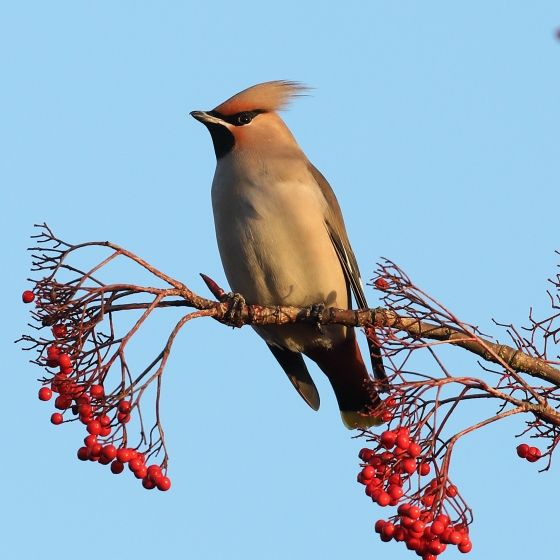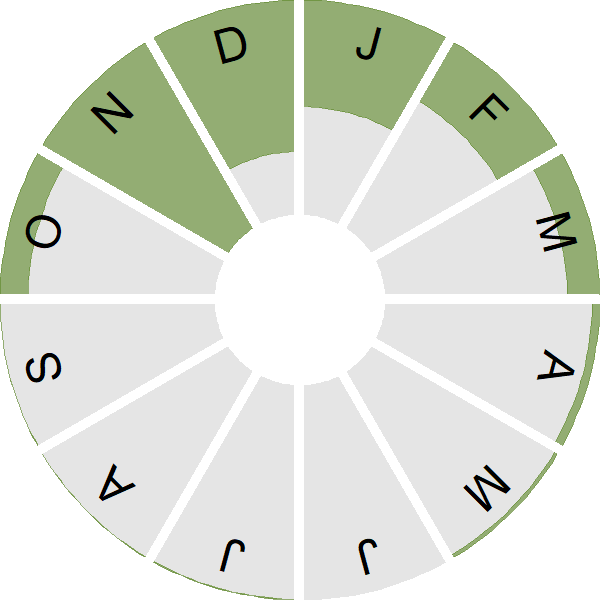Waxwing

Introduction
Pinky-buff and crested, the Starling-sized Waxwing is an irruptive visitor to the UK during the winter months.
Waxwings come to the UK in search of berries when crops run low closer to their breeding grounds in Fennoscandia and western Russia. As such can turn up at anytime during the winter and in varying numbers. This behaviour is known as 'irruptive' as, if berries remain plentiful in northern Europe very few Waxwings, if any, will move.
The Waxwing's favoured berry is that of the Rowan and during 'Waxwing winters', they can gather in large flocks at just a few Rowan trees. Waxings can turn up anywhere in the UK, but are less commonly reported in western regions than further east.

Key Stats
Identification
Songs and Calls
Call:
Status and Trends
Conservation Status
Population Change
Waxwing is a winter visitor to the UK; numbers are estimated at around 10,000 individuals [Woodward et al. 2020] but they can be seen in larger numbers, and across more of the UK, during irruptions years [Balmer et al. 2013]. Ring recoveries show that many Waxwings seen in northern UK come from Norway and that irruption movements are triggered by low Rowan berry abundance in Norway [Dale 2023]. The Waxwing population across Europe is thought to be strongly increasing [EBCC 2015]. There has only been one possible breeding record in the UK, when a pair was seen entering woodland in Caithness in June 2009 [Holling & the Rare Breeding Birds Panel 2011].
Distribution
Waxwing numbers vary annually, with irruptions occurring when Fennoscandian Rowan berry crops fail. Birds arrive in the Northern Isles and along the North Sea coast, where they can remain in large numbers if berries there are abundant. If the berry crop is poor, or as it becomes depleted, birds move south and west in search of food. During 2007–11 there were two major irruptions, in autumns 2008 and 2010. During the latter, severe weather brought about increased competition with resident species for berries and resulted in a mass exodus of Waxwings from parts of Scotland, with many being resighted subsequently as far away as the English south coast.
Occupied 10-km squares in UK
or view it on Bird Atlas Mapstore.
or view it on Bird Atlas Mapstore.
European Distribution Map
Distribution Change
The irruptive nature of Waxwings mean no two atlases are the same. The irruption and cold weather in 2010 contributed to a more-than-tenfold increase in range size at 10-km scale compared to during 1981–84.
Change in occupied 10-km squares in the UK
or view it on Bird Atlas Mapstore.
or view it on Bird Atlas Mapstore.
Seasonality
Waxwing is a winter visitor with numbers fluctuating widely from year to year; arrivals typically from late October onwards and may linger into early spring.
Weekly pattern of occurrence
The graph shows when the species is present in the UK, with taller bars indicating a higher likelihood of encountering the species in appropriate regions and habitats.

Movement
Britain & Ireland movement
Foreign locations of birds ringed or recovered in Britain & Ireland
Dots show the foreign destinations of birds ringed in Britain & Ireland, and the origins of birds ringed overseas that were subsequently recaptured, resighted or found dead in Britain & Ireland. Dot colours indicate the time of year that the species was present at the location.
- Winter (Nov-Feb)
- Spring (Mar-Apr)
- Summer (May-Jul)
- Autumn (Aug-Oct)

European movements
EuroBirdPortal uses birdwatcher's records, such as those logged in BirdTrack to map the flows of birds as they arrive and depart Europe. See maps for this species here.
The Eurasian-African Migration Atlas shows movements of individual birds ringed or recovered in Europe. See maps for this species here.
Biology
Productivity and Nesting
Nesting timing
Egg measurements
Clutch Size
Survival and Longevity
Survival is shown as the proportion of birds surviving from one year to the next and is derived from bird ringing data. It can also be used to estimate how long birds typically live.
View number ringed each year in the Online Ringing Report.
lifespan
Biometrics
Wing length and body weights are from live birds (source).
Wing length
Body weight
Ring Size
Classification, names and codes
Classification and Codes
- Order: Passeriformes
- Family: Bombycillidae
- Scientific name: Bombycilla garrulus
- Authority: Linnaeus, 1758
- BTO 2-letter code: WX
- BTO 5-letter code: WAXWI
- Euring code number: 10480
Alternate species names
- Catalan: ocell sedós comú
- Czech: brkoslav severní
- Danish: Silkehale
- Dutch: Pestvogel
- Estonian: siidisaba e. viristaja
- Finnish: tilhi
- French: Jaseur boréal
- Gaelic: Canranach-dearg
- German: Seidenschwanz
- Hungarian: csonttollú
- Icelandic: Silkitoppa
- Irish: Síodeiteach
- Italian: Beccofrusone
- Latvian: zidaste
- Lithuanian: paprastasis svirbelis
- Norwegian: Sidensvans
- Polish: jemioluszka (zwyczajna)
- Portuguese: picoteiro
- Slovak: chochlác severský
- Slovenian: pegam
- Spanish: Ampelis europeo
- Swedish: sidensvans
- Welsh: Cynffon Sidan
- English folkname(s): Silktail, Chatterer

